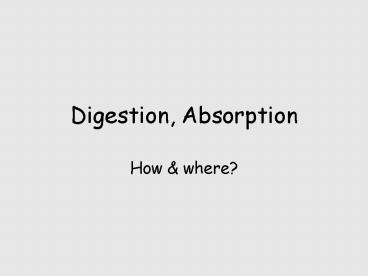Digestion, Absorption - PowerPoint PPT Presentation
1 / 36
Title: Digestion, Absorption
1
Digestion, Absorption
- How where?
2
What happens to food?
- Three processes
- Digestion
- Absorption
- Elimination
- Where do they occur?
- GI tract
3
Overview of Digestion
4
GI tract
- Gastrointestinal (GI) tract series of organs
(essentially sacs) arranged in a long tube - Ex stomach, small intestine
- Organs separated by circular muscles (sphincters)
5
How is the GI prepared before each meal?
- Cephalic phase
- Thinking about food
- Gastric phase
- Mechanical manipulation of food
6
Cephalic (Brain) phase
- Anticipatory phase
- Sensations (smell, sight, tactile), plus
association of previous meals stimulate MO - MO sends signals along nerve fibers to stomach
cells - Stimulate stomach cells to secrete goodies
- Positive feedback of gastrin
7
Digestion begins in mouth
- Chewing - mechanical digestion
- Adds saliva - softens and lubricates food
- Salivary amylase - Enzyme begins chemical
digestion of carbohydrates
8
Moved down esophagus
9
Into Stomach
Longitudinal
Circular
Diagonal
Three layers of muscle
10
Stomach jobs
- Mechanical digestion mixes food with gastric
juice (highly acidic!) - Chemical digestion of proteins and fats by
gastric juices - Hydrochloric acid (HCl)
- Pepsin
- Gastric lipase
- Protection of cells by secreting mucus
- Absorption
11
Stomach secretions
- Pepsin breaks covalent bonds between protein
monomers (Amino Acids). - HCl converts pepsinogen to pepsin low pH kills
microorganisms - Intrinsic factor binds to vitamin B12 to promote
absorption in SI (DNA synthesis RBC production) - Gastrin hormone regulates stomach secretions
influenced by hunger - Mucus lubricates and protects cells from chyme
(acidic) pepsinogen (protein digesting enzyme)
12
Gastric phase
- Most secretions
- Promoted by presence of food in stomach
- Stretching stimulates local CNS reflexes
(receptor type?) - Increases HCl pepsinogen secretion
- Peptides stimulate additional HCl secretion
13
Stomach cell anatomy
- Heavily infolded allows stretch
- 4 types cells
- Mucous mucus
- Parietal HCl intrinsic factor
- Chief pepsinogen
- Endocrine regulatory hormones
14
More stomach jobs
- Mix and churn the digesting mass into chyme
semi-solid product of mechanical and chemical
digestion - Absorb some H2O, fatty acids and drugs
- Store food and regulate release to small intestine
15
To Small Intestine
- Longest part of GI tract
- Three sections duodenum, jejunum, ileum
- Chyme enters through pyloric sphincter
- Chemical digestion continues (most takes place
here) using pancreatic enzymes and bile
16
Intestinal phase
- Food enters duodenum inhibits gastric
secretions - Chyme (pH lt 2.0)
- Duodenum releases secretin
- Lipids stimulate secretion of Cholecystokinin
(CCK) GIP
17
Show Three phases of gastric digestion vid
18
Small intestine Accessories
19
Accessory digestive organs help
- Liver produces secretes bile, which emulsifies
fats - Gall bladder stores bile
- Pancreas produces secretes proteinases,
lipases, nucleases amylase
20
Control of Bile secretion
- Nervous direct stimulation of gall bladder
- Hormonal A full duodenum releases
- Secretin bile salts stimulates release of bile
by liver - CCK stimulates release of bile by gall bladder
21
Control of pancreatic secretions
- Hormonal
- Secretin increases secretions
- CCK increases secretion of digestive enzymes
- Nervous
- Parasympathetic stimulation increases enzyme
secretion
22
The pH Scale
pHs of common substances
Basic
Concentrated lye
14
Oven cleaner
13
12
Household ammonia
11
10
Baking soda
9
Bile
Pancreatic juice
8
Blood
pH neutral
Water
7
Saliva
Urine
6
Coffee
5
Orange juice
4
Vinegar
3
Lemon juice
2
Gastric juice
1
Battery acid
Acidic
0
23
Small intestinedigests and absorbs
- Absorption the process of moving molecules
across a cell membrane and into a cell - Small amount of absorption occurs in the stomach
- Most absorption of nutrients occurs in the small
intestines
24
Specialized for absorption
- Lining of GI tract has special structures to
facilitate absorption - Villi are folds in the lining in close contact
with nutrient molecules - The brush border is composed of microvilli which
greatly increases surface area (SA)
25
Folds encourage absorption
26
Overview of Digestion
27
Carrier loads nutrient on outside of cell . . .
Carrier loads nutrient on outside of cell . . .
Outside cell
Cell membrane
. . . and then releases it on inside of cell.
. . . and then releases it on inside of cell.
Inside cell
Fig. 3-9, p. 81
28
Carbohydrate absorption
- Cotransport into cells
- Facilitated diffusion into capillaries
29
Fat absorption
- Bile salts surround glycerides (micelles)
- Micelles merge with PM of cells
- Monoglycerides built into triglycerides covered
with protein coat - Exocytosis movement into lacteals
30
Protein absorption
- AA short peptides absorbed via cotransport
- Active transport into capillaries
- Off to the liver
31
Vitamins minerals
- Absorbed in small and large intestine
- Dissolved in lipids
- Via carrier proteins
- Via diffusion through membrane channels
32
Large intestine
- Undigested food moves through illeocecal valve
(sphincter) to large intestine - Very little digestion
- Material is stored 12-24 hours prior to
elimination - Water and some nutrients are absorbed
33
Large intestine
- Mostly fiber, bacteria and H20 remain
- Beneficial bacteria continue to digest food
(byproducts are short chain fatty acids) - Elimination
34
(No Transcript)
35
Destination of nutrients
- Lipids and lipid soluble vitamins enter lymph
system This empties into bloodstream - All others enter bloodstream directly
- Nutrients travel to liver where they are stored,
processed and their release regulated - Liver filters ALL your blood
36
Nutrient delivery































